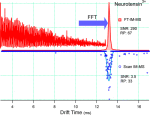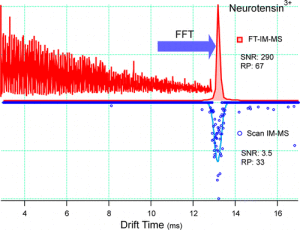We are pleased to report the publication of our work outlining the effective coupling of a drift tube IMS system with an ion trap mass spectrometer. Compared to previous implementations (see our 2005 publication) we have dramatically improved the IMS duty cycle by encoding the mobility information in the frequency domain. Using this Fourier approach we can cover the full mobility spectrum in a fraction of the time that is typically required for a signal averaging technique. Perhaps most impressive from our perspective, is the ease of implementation. It is truly plug ‘N play with no hardware synchronization required. If anyone is interesting in more details regarding the pulsing hardware and parameters, you know where to find us.
Abstract: Historically, high pressure ion mobility drift tubes have suffered from low ion duty cycles and this problem is magnified when such instrumentation is coupled with ion trap mass spectrometers. To significantly alleviate these issues, we outline the result from coupling an atmospheric pressure, dual-gate drift tube ion mobility spectrometer (IMS) to a linear ion trap mass spectrometer (LIT-MS) via modulation of the ion beam with a linear frequency chirp. The time-domain ion current, once Fourier transformed, reveals a standard ion mobility drift spectrum that corresponds to the standard mode of mobility analysis. By multiplexing the ion beam, it is possible to successfully obtain drift time spectra for an assortment of simple peptide and protein mixtures using an LIT-MS while showing improved signal intensity versus the more common signal averaging technique. Explored here are the effects of maximum injection time, solution concentration, total experiment time, and frequency swept on signal-to-noise ratios (SNRs) and resolving power. Increased inject time, concentration, and experiment time all generally led to an improvement in SNR, while a greater frequency swept increases the resolving power at the expense of SNR. Overall, chirp multiplexing of a dual-gate IMS system coupled to an LIT-MS improves ion transmission, lowers analyte detection limits, and improves spectral quality.


Comments are closed